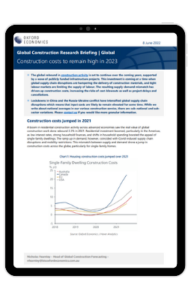Global construction costs to remain high in 2023

The global rebound in construction activity is set to continue over the coming years, supported by a wave of publicly funded infrastructure projects. This investment is coming at a time when global supply chain disruptions are hampering the delivery of construction materials, and tight labour markets are limiting the supply of labour. The resulting supply-demand mismatch has driven up construction costs, increasing the risks of cost-blowouts as well as project delays and cancellations.
Lockdowns in China and the Russia-Ukraine conflict have intensified global supply chain disruptions which means that input costs are likely to remain elevated for some time. While we write about national averages in our various construction service, there are sub-national and sub-sector variations. Please contact us if you would like more granular information.
What you will learn:
-
The global rebound in construction activity is set to continue over the coming years, supported by a wave of publicly funded infrastructure projects. This investment is coming at a time when global supply chain disruptions are hampering the delivery of construction materials, and tight labour markets are limiting the supply of labour. The resulting supply-demand mismatch has driven up construction costs, increasing the risks of cost-blowouts as well as project delays and cancellations.
- A boom in residential construction activity across advanced economies saw the real value of global construction work done rebound 2.3% in 2021. Residential investment boomed, particularly in the Americas, as low interest rates, strong household finances, and shifts in household spending boosted the appeal of single-family dwellings.
- Global supply chains have remained stretched since the middle of 2020 and, with strong consumer and industrial demand for goods, has driven a jump in global container shipping charter rates. The construction sector is much more exposed to transportation costs than other parts of the economy due to the relatively low value-to-weight ratio of construction materials.
Tags:
Related posts

Post
How Canada’s wildfires could affect American house prices
The Northern Hemisphere is now heading into the 2024 fire season, having just had its hottest winter on record. If it is anything like last year, we can expect to see further impacts on people, nature, and global markets.
Find Out More
Post
Major China cities face prospect of growth downshift
Over the next five years China and its major cities face the prospect of a significant downshift in economic growth. We forecast GDP to grow on average by 4.1% per year across 15 major cities in the years to 2028, down from 7.3% between 2015-2019.
Find Out More
Post
US metros to see decelerating growth in the medium term
We forecast stable GDP growth across most US metros in 2024, followed by decelerating growth over the subsequent four years. All of the top 50 metros are forecast to see real GDP growth in 2024 as well as continued but slower growth through 2028.
Find Out More